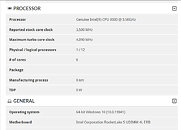Friday, May 22nd 2020

Intel Rocket Lake CPU Appears with 6 Cores and 12 Threads
We have been hearing a lot about Intel's Rocket Lake lineup of processors. They are supposed to be a backport of Willow Cove 10 nm core, adapted to work on a 14 nm process for better yielding. Meant to launch sometime around late 2020 or the beginning of 2021, Rocket Lake is designed to work on the now existing LGA1200 socket motherboards, which were launched just a few days ago along with Intel Comet Lake CPUs. Rocket Lake is there to supply the desktop segment and satisfy user demand, in light of lacking 10 nm offers for desktop users. The 10 nm node is going to present only on mobile/laptop and server solutions before it comes to the desktop.
In the latest report on 3D Mark, the hardware leaker TUM APISAK has found a Rocket Lake CPU running the benchmark and we get to see first specifications of the Rocket Lake-S platform. The benchmark ran on 6 core model with 12 threads, that had a base clock of 3,5 GHz. The CPU managed to boost up to 4,09 GHz, however, we are sure that these are not final clocks and the actual product should have even higher frequencies. Paired with Gen12 Xe graphics, the Rocket Lake platform could offer a very nice alternative to AMD offerings if the backport of Willow Cove goes well. Even though it is still using a 14 nm node, performance would be good. The only things that would be sacrificed (from backporting) are die space and efficiency/heat.
Source:
@TUM_APISAK (Twitter)
In the latest report on 3D Mark, the hardware leaker TUM APISAK has found a Rocket Lake CPU running the benchmark and we get to see first specifications of the Rocket Lake-S platform. The benchmark ran on 6 core model with 12 threads, that had a base clock of 3,5 GHz. The CPU managed to boost up to 4,09 GHz, however, we are sure that these are not final clocks and the actual product should have even higher frequencies. Paired with Gen12 Xe graphics, the Rocket Lake platform could offer a very nice alternative to AMD offerings if the backport of Willow Cove goes well. Even though it is still using a 14 nm node, performance would be good. The only things that would be sacrificed (from backporting) are die space and efficiency/heat.

38 Comments on Intel Rocket Lake CPU Appears with 6 Cores and 12 Threads
Differently.
Now, they finally knew what was going wrong but fixing it is not simple or quick. The lead time for a major change in CPUs is in years. A new CPU generation takes about a year to year and a half to do if not more. Somewhere in the mid to late 2018 Intel reportedly started a project to untie architecture from manufacturing process - this was never really the case with Intel CPUs as they had tight integration between architecture and manufacturing which had been a benefit for them. This rumored/reported project is part of why Rocket Lake rumors are what they are - Intel should by now be able to port CPU architecture to various manufacturing nodes including a newer architecture like Willow Cove back to 14nm.
If the rumors and reports from anonymous sources are true, this fits quite well with the timeline here.
Anyway if total performance will be higher compared with current chips, single core performance would be amazing
I don't know if was related, but perhaps that's why Nvidia's Kepler arhitecture was abandoned so fast and aged poorly - because maybe it wasn't the design Nvidia wanted but an ugly kludge to make the 28nm design work at 40nm...?
and even 3nm very very soon. I mean it is just such a letdown to buy anything using DDR4 right now.
Just such a waste buying anything on 7,14nm. All the same, old beta testing devices.
The initial performance of Willow doesn't look promising. the physics score 3dmark is lower than 10400F.
I expected ground breaking performance, +40% or something.
Nvidia chose to cut back on compute resources and implement TBR, AMD stuck with what they had.
On 28nm, both Nvidia and AMD chose to keep their designs on 28nm for two generations (Kepler and Maxwell for Nvidia). Nvidia did release 20nm products, but not as consumer GPUs (Tegra X1 in the Switch was an odd 20nm part). Due to TSMC's struggles with 28nm, then 20nm, Nvidia and AMD would both move some (though not all) production away from TSMC for their next consumer products. Nvidia went to former enemy Samsung and AMD went to former spinoff GloFo. TSMC would shore up their 20nm process with FinFETs (sparking a renaming to "16nm," despite keeping the same planar density for the most part) and all was well again.
It should be noted, this whole thing with TSMC and 28nm also drove Apple to go back to Samsung to dual source parts, too.
If I had to guess, TSMC 28nm caused a lot of partners to lose trust and faith in TSMC's delivery. This was around the time TSMC lost one of their process development chiefs to Samsung (now at SMIC), over internal politics at TSMC. Samsung's 14nm, developed under him, was quite successful. It took clients away from TSMC and was licensed to GloFo to rescue that dumpster fire for a few more years.
www.overclockers.co.uk/intel-core-i5-10400f-2.90ghz-comet-lake-socket-lga1200-processor-retail-cp-680-in.html
Nope. Intel is slower multithreaded and draws more power per core. The only thing they win in is applications that use a handful of cores at high frequency, which is increasingly a dying breed in a world of 8 core laptops and 16 core desktops.
If you look at a one dimensional metric, then yes, Intel's 14nm is able to clock faster than a TSMC 7nm. But at the expense of it taking more than 2x the power. Clock for clock, Intel's ageing Skylake architecture will lag behind, thus the desperate need to increase clockspeed to retain the single core performance crown. Unfortunately, the earliest you can see a 7nm from Intel could be late next year if not the year after, assuming no delays. The current Intel 10nm appears to be completely messed up. While Intel claims that its turning out better than they expected, I am not sure how high is the expectation now after the many years of delay.